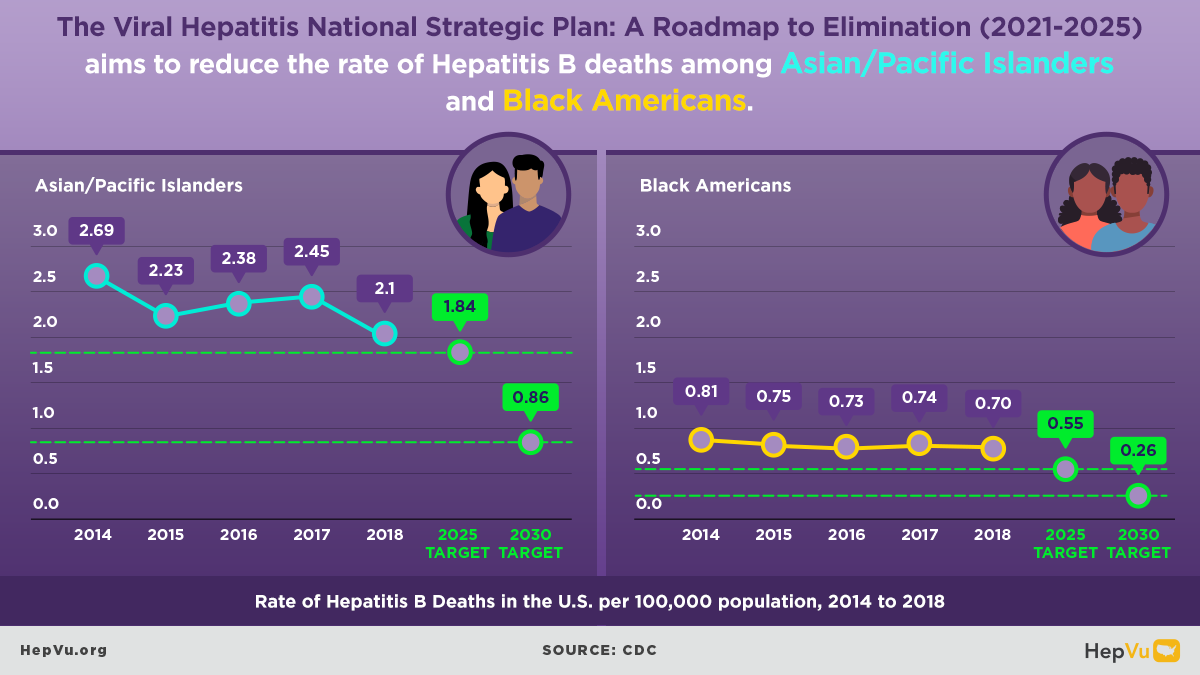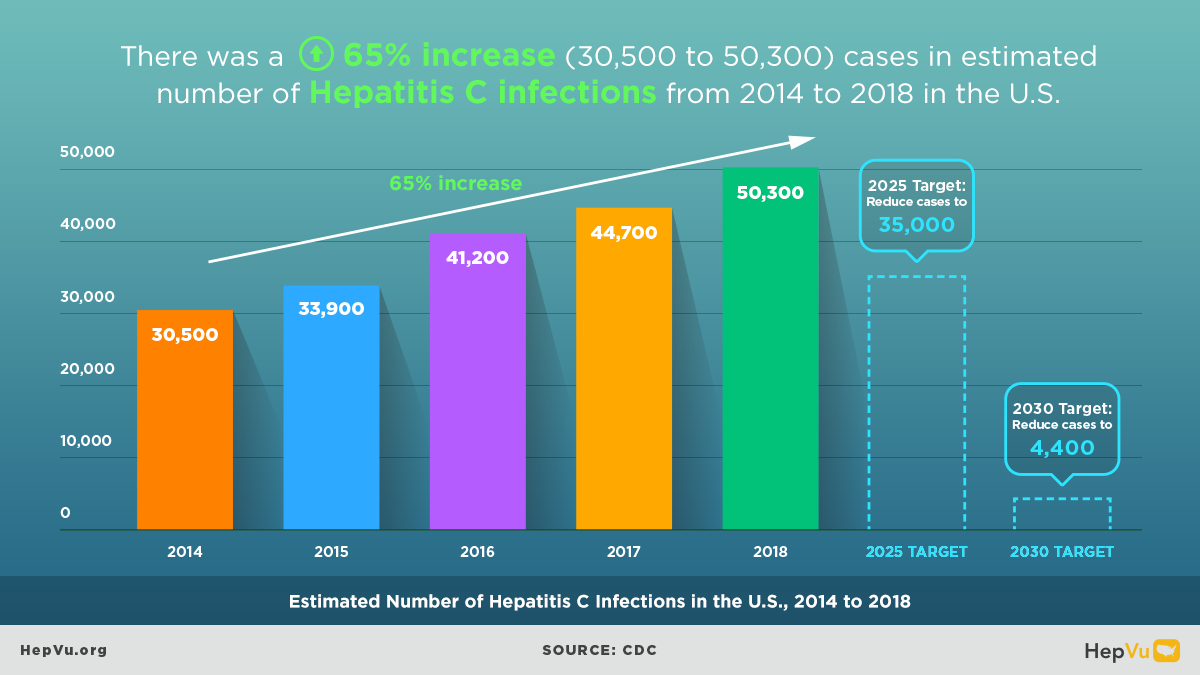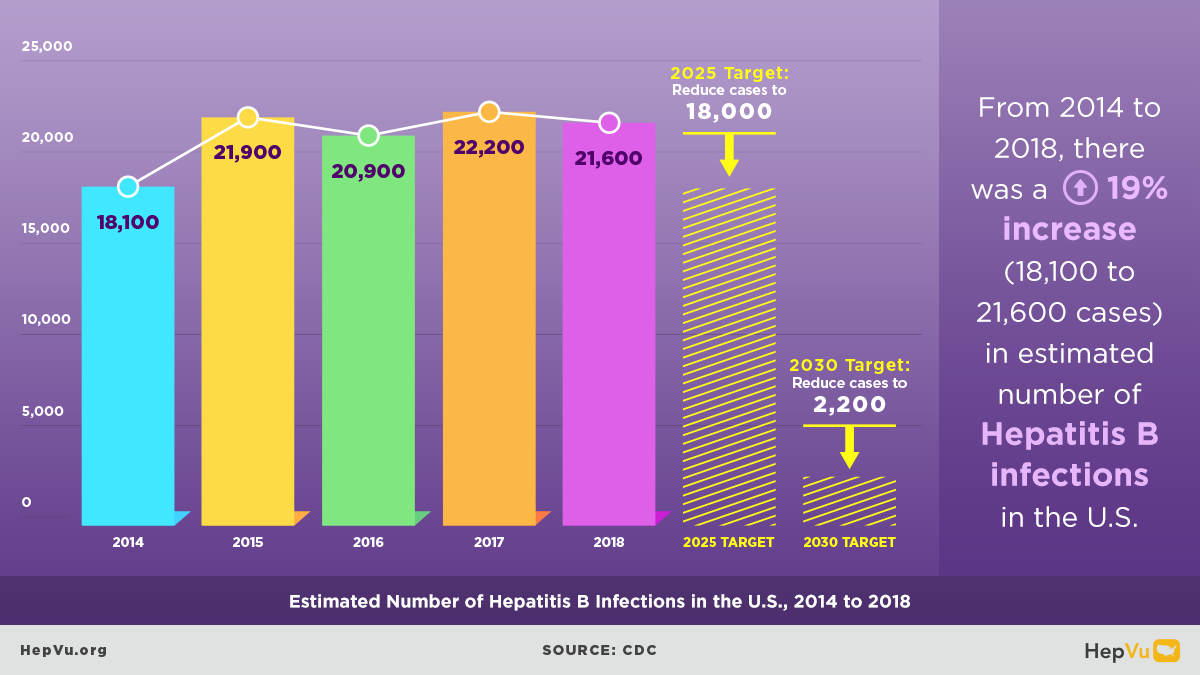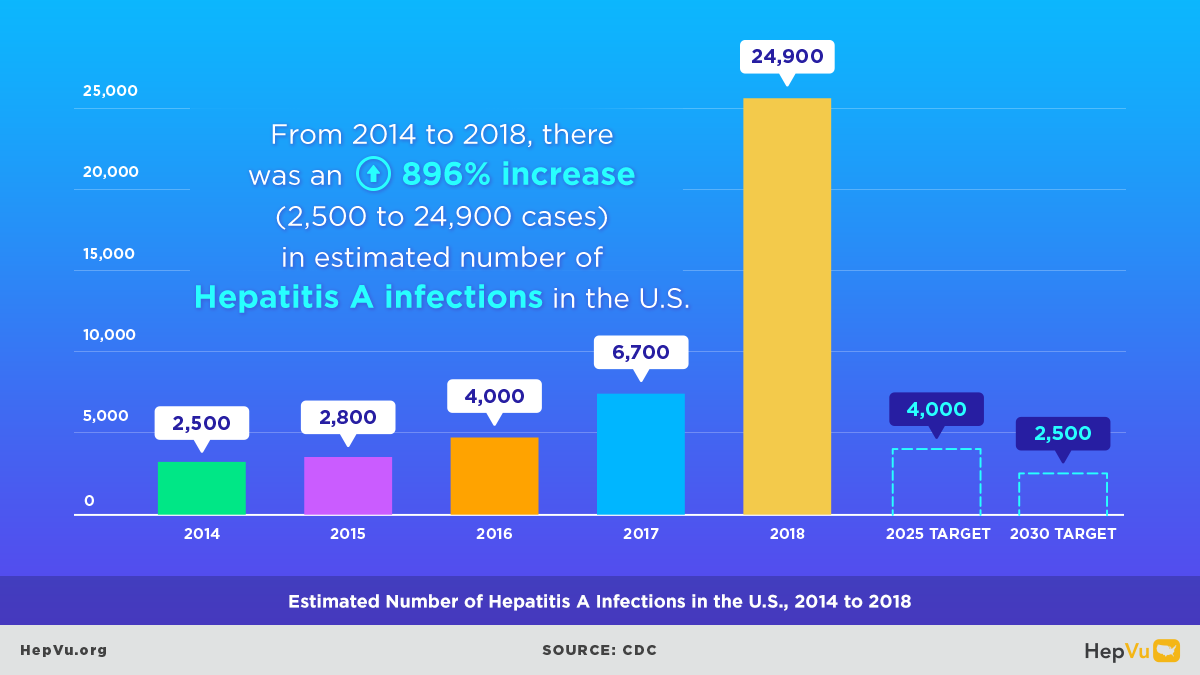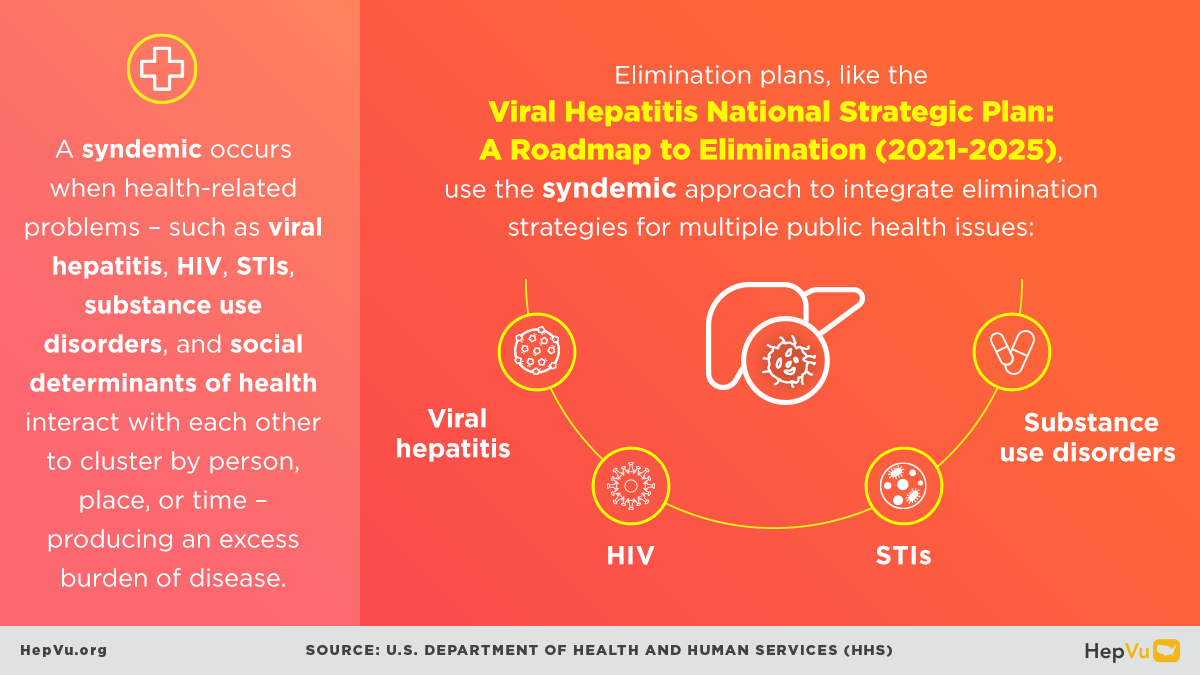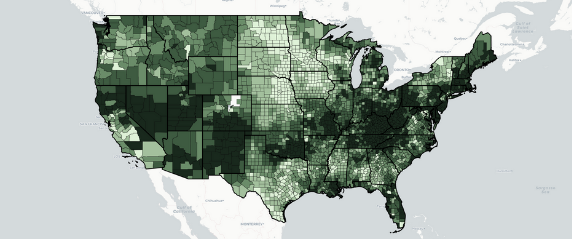In January 2021, the U.S. Department of Health and Human Services (HHS) released its Viral Hepatitis National Strategic Plan: A Roadmap to Elimination 2021-2025. The plan outlines objectives and strategies to aid stakeholders—researchers, policy makers, health care providers, advocacy groups, and patients—in working together to eliminate viral hepatitis as a public health threat in the U.S.
As of 2021, as many as 7 million people in the U.S. have viral hepatitis with numbers rising in Hepatitis A, B, and C cases across the country. The recent increases in Hepatitis B infections are likely linked to the ongoing opioid crisis in specific regions in the U.S. Despite these numbers, elimination efforts have stalled, and the COVID-19 pandemic continues to strain resources and reinforce barriers to care.
According to the World Health Organization (WHO), viral hepatitis elimination is defined as a 90% reduction in new infections and a 65% reduction in hepatitis-related deaths. In its 2016 agenda, the WHO set their goals to achieve viral hepatitis elimination by 2030. Highlighting the dangers of viral hepatitis and its negative effects that can lead to other diseases such as liver cancer, the WHO strongly recommended countries develop their own national elimination plans.
However, the COVID-19 pandemic has dramatically hampered hepatitis elimination efforts worldwide as reallocation of resources and global attention turned to COVID-19. The U.S. Viral Hepatitis National Strategic Plan 2021-2025 comes at an urgent time when our nation must focus on a comprehensive viral hepatitis elimination strategy amidst competing public health challenges at the federal, state, and local levels.
HHS’ Plan
Overall, HHS’ plan aims to eliminate obstacles to hepatitis screening, prevention, care, and treatment through setting five specific goals:
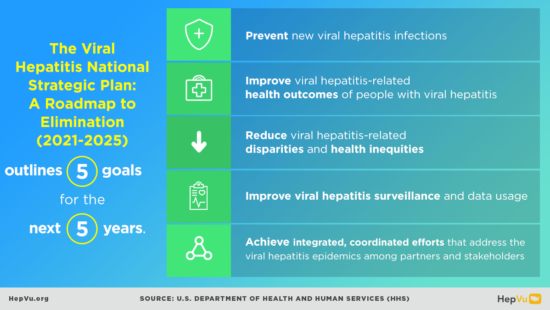
- Prevent new viral hepatitis infections
- Improve viral hepatitis-related health outcomes of people with viral hepatitis
- Reduce viral hepatitis-related disparities and health inequities
- Improve viral hepatitis surveillance and data usage
- Achieve integrated, coordinated efforts that address the viral hepatitis epidemics among partners and stakeholders
Progress to Elimination
Over the past decade, three national viral hepatitis plans have been published with evolving priorities:
- In 2011, the “Combating the Silent Epidemic of Viral Hepatitis: Action Plan for the Prevention, Care & Treatment of Viral Hepatitis” prioritized all strains of viral hepatitis (A, B, C, D, and E) and focused on federal intervention.
- In 2014, “Action Plan for the Prevention, Care and Treatment of Viral Hepatitis” targeted every strain of viral hepatitis, focusing on increasing screening, reducing Hepatitis C infections, and eliminating perinatal Hepatitis B transmissions.
- Subsequently, the “National Viral Hepatitis Action Plan” published in 2017 established improved support for national viral hepatitis data surveillance and restructured former plans to align with non-governmental and local support.
Based on the 2017-2020 Action Plan’s indicators, the U.S. is currently on track to achieve the 2020 target for reducing Hepatitis B-related deaths, Hepatitis C-related deaths, and Hepatitis C-related deaths among African Americans. However, the country is falling behind in reducing Hepatitis B and C infections, especially among priority populations such as Asian American and Pacific Islanders and people aged 30 to 49 years.
CDC’s Division of Viral Hepatitis 2025 Strategic Plan
In September 2020, the Centers for Disease Control and Prevention’s Division of Viral Hepatitis (CDC DVH) released the DVH 2025 Strategic Plan. The plan’s goals include:
- Reducing viral hepatitis infections
- Reducing viral hepatitis-related morbidity and mortality
- Reducing viral hepatitis-related disparities
- Establishing comprehensive national viral hepatitis surveillance
The goals and objectives of the DVH plan align with those of the HHS plan, such as reducing disparities among marginalized populations, improving viral hepatitis surveillance, and leveraging partnerships across all federal, state, and local levels. Developed with the global public health goal of eliminating viral hepatitis by 2030 in mind, the CDC DVH plan focuses on the next five years as a critical period in viral hepatitis elimination in the U.S.
Local Viral Hepatitis Elimination Plans
The Viral Hepatitis Strategic Plan 2021-2025 also highlights the need to reduce hepatitis-related disparities and health inequities related to social determinants of health, especially among priority populations. These inequities lead to missed opportunities in vaccination, lack of screening, health care provider limitations, scarce data, and more. Although the plan provides helpful guidance on objectives to achieve this goal, state and local organizers must remain cognizant of their own communities’ needs and priorities in creating their own elimination strategies to ensure their elimination activities are inclusive and equitable.
Across the country, there are already a few regions that have established elimination plans similar to the national plan, such as Hawaii’s Hep Free 2030 and Washington’s Hep C Free Washington Plan to Eliminate Hepatitis C in Washington State by 2030. Some of these plans work to target viral hepatitis elimination from the state-level while others focus on local organizations and clinics to improve hepatitis-related infrastructure. For more information about the existing state and local elimination plans in action across the U.S., explore this map from the U.S. Department of Health and Human Services.
Microelimination
Rapidly tackling Hepatitis C in a specific group is known as microelimination. Microelimination is less daunting, less complex, and less costly than full-scale, country-level initiatives to eliminate Hepatitis C, and it can build momentum by producing small victories that inspire more ambitious efforts. Some notable microelimination efforts include the plan to eliminate Hepatitis C in prisons and jails, within the Cherokee nation, among people living with HIV, and among people who inject drugs (PWID).
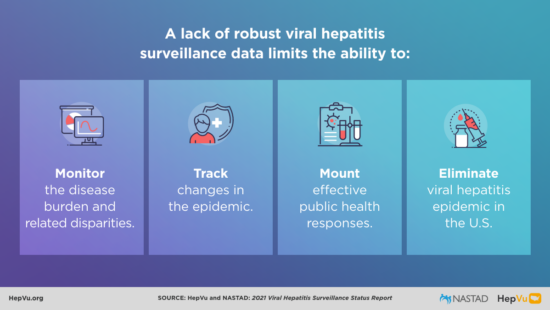
Surveillance
The National Strategic Plan underscores a severely underfunded and underdeveloped, but critical component of viral hepatitis elimination: surveillance. The national plan’s surveillance goals expand on previous plans by delineating strategies to share data beyond just national and state levels, but to local, tribal, and territorial health departments as well. In addition, the plan’s strategy to develop a comprehensive evaluation of viral hepatitis in the country through routine analysis requires a collaborative approach from health departments, community-based organizations, and health care providers. These tactics will be implemented along all points of the viral hepatitis continuum of care to ensure that data is constantly updated to inform the most accurate public health action.
4 Ways to Use HepVu
Explore Interactive Maps
View Local Statistics
View local statistics for your state, and download high-impact data visualizations for your work
See the Data
Download Data
See the DataLearn from Experts

October 21, 2020
Thaddeus Pham on Hawaii’s Viral Hepatitis Elimination Strategy
Thaddeus Pham is the Viral Hepatitis Prevention Coordinator for the Hawaii Department of Health’s Harm Reduction Services Branch as well as the co-Founder and co-Director of the Hep Free Hawaii Coalition. Q: Earlier this summer, Hep Free Hawaii, a coalition of over 90 organizations, released its first viral hepatitis elimination strategy for the state of
Read More
December 2, 2019
Vu Q&A: Monica Graybeal on Ending Hep C in Washington State
Dr. Monica Graybeal, PharmD, is a Hepatitis C ambulatory and community pharmacist at Yakima Valley Farm Workers Clinic and an adjunct professor at Washington State University. Q: You’ve been working to diagnose, treat, and care for Hepatitis C patients at the Yakima Valley Farm Workers Clinic in Spokane, Washington, for more than a decade.
Read More
June 5, 2019
Vu Q&A: Shauna Onofrey on Hepatitis C Elimination Efforts in Massachusetts
Shauna Onofrey, MPH is an Epidemiologist at the Massachusetts Department of Public Health Q: You have focused on viral hepatitis in roles with the Centers for Disease Control and Prevention (CDC) to the Massachusetts Department of Public Health (MDPH). How have viral hepatitis and the Hepatitis C epidemic in the U.S. evolved during the course
Read MoreFor More Information
Additional information about viral hepatitis elimination can be found at the following resources.
U.S. Centers for Disease Control and Prevention
The National Viral Hepatitis Progress Report provides information on progress in the implementation of recommended interventions and the impact these interventions are having on the prevention of viral hepatitis transmission, disease, and associated mortality.
Learn MoreU.S. Department of Health and Human Services
A growing number of hepatitis elimination projects are being established across the United States. These projects implement the Viral Hepatitis National Strategic Plan’s call for more coordinated and collaborative efforts aimed at elimination.
Learn MoreWorld Health Organization
The first global health sector strategy on viral hepatitis, a strategy that contributes to the achievement of the 2030 Agenda for Sustainable Development.
Learn MoreThe Task Force for Global Health
The Task Force for Global Health takes on the world’s worst and most intractable diseases to eliminate them or bring them firmly under public health control while strengthening health systems so that countries can protect the health of their populations.
Learn More
